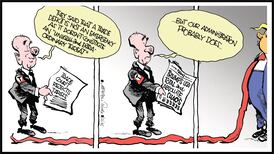Admirers of the Irish composer Charles Villiers Stanford, whohas been described as a “masterly musical architect” with an”extraordinary range”, are not exactly thick on the ground; in factthey could well be described, in Frank O’Connor’s phrase, as asubmerged population group, or perhaps an endangered species.
But in recent years there have been signs of a revival ofinterest in Stanford's work, with a number of CDs being released.These include Stanford's first and second string quartets with theVanbrugh Quartet (Hyperion) and his Requiem and other worksrecorded by the RTÉ Philharmonic Choir with the NSO andsoloists conducted by Adrian Leaper and Colman Pearce, transferredfrom Marco Polo to the Naxos label. Not long ago Chandos broughtout a two-disc compilation of his orchestral music including thePiano Concerto No 2 with the Ulster Orchestra under Vernon Handley.More recently the same company released a CD of songs performed bythe outstanding baritone Gerald Finley with the BBC Welsh Orchestraand Richard Hickox.
This attention paid by record companies to Stanford's work isvery welcome but, as one enthusiast complained to me, in thecountry of his birth there's no real interest in his work outsidechurch walls. However, a big step towards encouraging interest inthe composer has recently been taken in Cambridge. Thanks in largepart to the efforts of an American admirer, John Covell, theStanford Society was launched with a weekend of special eventssupported by the Cambridge University Musical Society. But whyCambridge? Well, when Stanford was 18 he enrolled as anundergraduate organ scholar at the university's Queen's College. Hetransferred to Trinity College three years later and was appointedprofessor of music in 1887, a position he retained until shortlybefore his death in 1924. Since he had made an outstandingcontribution to the musical life of Cambridge for more than 50years it was only right that he should be honoured there.
If Cambridge was slow to acknowledge its debt to Stanford, andneeded to be prompted by John Covell and his associates, theweekend programme of talks, concerts and services made ampleamends. On the Saturday, the well-known baritone Stephen Varcoegave a recital of songs by Stanford and some of his pupils at theuniversity's concert hall. These included spoof settings of EdwardLear limericks by "Karel Drofnatzki" (as Stanford transmogrifiedhis name) using passages from composers such as Verdi and Wagner.Despite long residence in England, Stanford's Irish sense of humourplainly didn't desert him.
The main concert, given in Trinity College Chapel that evening,began with the Magnificat for double chorus written just before thedeath of the composer Hubert Parry (with whom he had quarrelled),and dedicated to his memory. After the Fantasia and Toccata in Dminor for organ, Three Motets, and the 3rd Piano Trio, the concertended with the magnificent Coronation Gloria. This last piece waswritten for the coronation of King George V in 1911 and was usedagain for the coronation of the next and present monarchs. Stanford- politically a staunch unionist - would have felt gratified.
Later, at a reception in King's College for the unveiling of ablue plaque to Stanford, it was a pleasure to meet Melissa Webb(younger daughter of the late Prof WB Stanford of TCD) and herhusband Marcus, over to lend their support to the event. Members ofthe TCD Association's Cambridge and London branches were also thereto help fly the flag on behalf of one of Dublin's mostdistinguished sons.
I mentioned that Stanford and Parry fell out. As we heard thenext day from Prof Jeremy Dibble, relations between Stanford andEdward Elgar also turned sour after the Irishman took offence atsome of Elgar's remarks.
They were eventually reconciled, though some coolness remained.Stanford was perhaps a man too easily angered, but in Prof Dibble'sview he was less to blame than Elgar for the quarrel. Prof Dibble,who has published a book on Stanford, was lecturer in music atUniversity College Cork before joining Durham University in 1993.He is currently working on a short study of the Italian pianist andcomposer Michele Esposito who lived and worked in Dublin almost allhis professional life.
Prof Dibble's lecture was followed by Evensong in King's CollegeChapel. In this marvellous building dating from the reign of HenryVI we heard more of Stanford's music, including a Magnificat andNunc Dimittis and the anthem A Song of Wisdom, all beautifullysung. It was a moving tribute to a great Irishman with a fair claimto be the finest composer his country has produced, a worthyrecipient of the knighthood bestowed on him in 1901. Probably theconservatism of his musical language (like that ofSaint-Saëns) tended to make his work go out of fashion morequickly than it might otherwise have done. Those in search of ahighly individual sound world will not find it in Stanford. But hewas a composer of inspiration and extraordinary craftsmanship invirtually every genre. His work should be heard more often.Fortunately the Stanford Society has now been established to makethat case.
Membership application forms are available from: Stephen Frost,Membership Secretary, The Stanford Society, 110 Beauval Road,London SE22 8UH. E-mail: stanfordsociety@aol.com.
Web: www.thestanfordsociety.org






